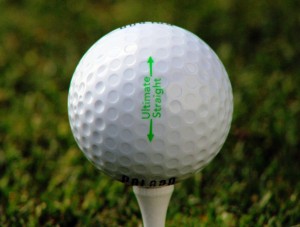
The Polara needs to be manually pointed in the right direction, one of the reasons it's not meant for competition.
It was on a whim that I shoved a couple of sleeves of Polara golf balls into my bag before the trip to Ireland. They’re meant to reduce hooks and slices – by as much as 75 percent, it’s claimed – thanks to an innovative dimple pattern.
As Polara spokespeople acknowledge forthrightly, the non-USGA-conforming balls are illegal for competition, even, presumably, for the beer-buying stakes of games we played. So we didn’t give them the full-blown road warrior test, but I was moved to think about the Polara’s avowed raison d’etre: To allow golfers to have more fun.
That’s because while spraying shots is painful on any course, doing it on a links course – typically in stiff winds and lined with hay-like grasses on steep dunes – can be excruciating. (Sandy Hills Links, at Rosapenna, comes to mind.)
Purists will probably label the Polara a “golf ball,” an interloper. And I’m living proof that the courses we play in Ireland are a blast regardless of the quality of play. But I certainly couldn’t fault anyone focused primarily on keeping the ball in view more and speeding pace of play.
All that depends, of course, on whether the balls work as advertised, and our admittedly cursory trials at Tralee suggest they do. The trajectory is lower, sidespin is indeed substantially diminished.
No guarantee, naturally, that you’ll hit it where you want, and the wind will still grab it – something that made evaluating the claim that you gain two clubs’ distance difficult to evaluate.
Bloody ‘ell, mate, I could change my name to O’Hara and be a Polara rep, maybe based in Galway; or, given the way I’ve sometimes played, a Polara poster boy.
# # #
